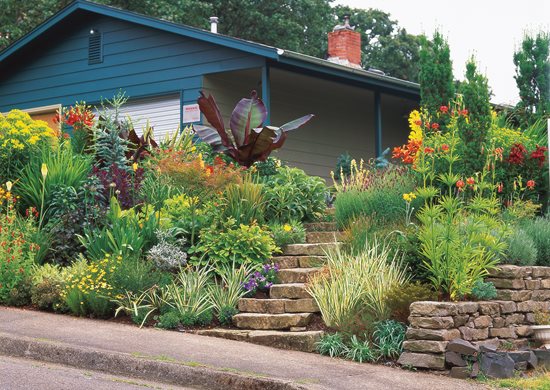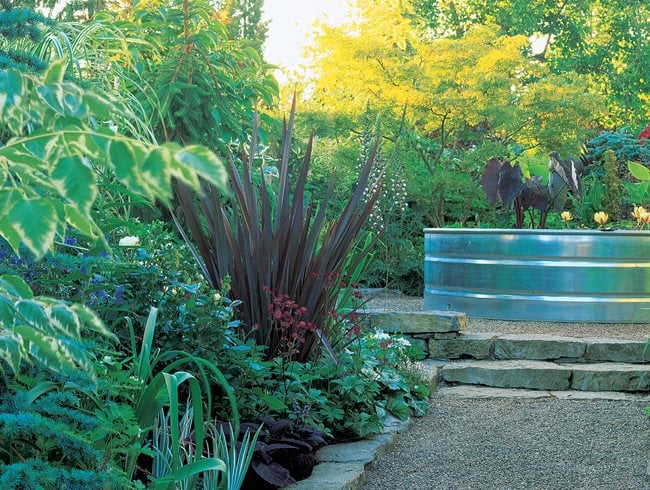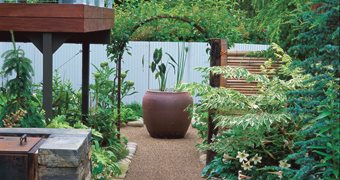Simplicity & Structure Rule in This Small Garden
A tiny, narrow lot in Eugene, Oregon becomes a pocket-size garden full of treasures5 Big Ideas for a Small World
- Keep it simple
Consistency of materials is key to uniting a small space. From the myriad of options at our local stone yards, we chose a British Columbia basalt for the main garden. We couldn’t resist the river rocks, but we confined them to the vegetable garden. - Think big
Ample pathways and gathering spaces are inviting, and large features are engaging in any size garden. Our 7-foot-wide stock-tank water feature (direct from the farm supply store) is a universal hit. - Don’t hold back
Big changes can take less time, effort and money and have greater impact in a small space. - Create a backdrop
With attention to color, fences and walls provide ideal backdrops for plantings. Our silvery fence, made from corrugated roofing panels, brightens our garden and highlights dark foliage plants. A bold, dark blue exterior color (Benjamin Moore Stonecutter) sets off bright colors against the house. - Use the house
The house is the largest feature of any small property—consider it part of the garden. Guests linger by the front door, which makes it an ideal location for a terrace or patio. Doors and windows create ideal axes on which to place features.
When Buell Steelman and I bought a semi-neglected ranch-style house at the top of a tiny, narrow, sloping, treeless lot in Eugene, Oregon, its only outdoor “features” were two ramshackle sheds, several haphazardly placed fences and 1,200 square feet of concrete. Affordability clearly trumped charm, but the unusual dimensions of the outdoor space and the large living-room window that overlooked the future garden and hills to the west sparked our imaginations. We like to think we created a space that is uniquely ours—a showcase of our work and a reflection of our passions.
Buell and I met while working at Gardens, a groundbreaking landscape architecture design/build company in Austin, Texas. Neither of us had a background in landscaping, and we stumbled on positions at Gardens by chance. The company’s use of strong lines, bold plantings, and contemporary and traditional materials immediately appealed to our tastes and talents. We loved our work, but we craved a smaller city in a milder climate. We later moved to Eugene to create our own garden design/build business, Mosaic. We borrowed our objectives from James David, Gardens’ founder: Design powerful spaces, build them to the highest standard of quality, constantly push the boundaries of your work and start with your own garden.
In our new space, we sought to incorporate the classical-contemporary style of our work in Austin with the plants, materials and atmosphere of the Pacific Northwest. We needed to experiment and showcase our work, but we most desired a space that reflected our love of food, entertaining and of course gardening. From our first look at the property, we understood that its limited size would challenge us to focus and define our goals.
The structure and utility of the garden were our first concerns. We adore plants, and our temperate climate offers limitless horticultural possibilities, but we delayed all planting decisions until we had addressed our priorities and installed a powerful hardscape. Mindful of our love of food, we allotted one-third of our space to a small fruit orchard and an orderly vegetable garden bordered with river rock. In the main garden, we built ample pathways, terraces and a deck to provide guests space to travel, gather and enjoy the view. Plants soften the strong lines of our space, but the structure is the garden’s inviting essence.
The relationship between house and garden is paramount in small spaces. Buell and I echoed the simple lines of our house with straight paths, and we organized features and terraces outside of primary windows and doors. We centered our most dramatic focal point on our favorite west-facing window. The 7-foot-diameter galvanized stock tank is an impressive feature, filled in summer with lotus, thalia and water lilies. Its surrounding gravel terrace heightens the impact of the feature from the window, drawing attention into the garden and joining it with the view of the Coast Range and western sky beyond.

Hot colors dominate the steeply sloping front garden.
SEE MORE OF THIS GARDEN
Relating indoors and out required creative rethinking of the house, as well as the garden. To integrate the elevated, windowless back of our house with the garden, we installed a sliding glass door leading to a new deck, or transitional “room,” outside. The deck made of ipe (tropical hardwood) now serves as our primary spot for entertaining. The furnishings reflect the minimalist interior of our house, while a living bamboo screen growing in galvanized stock tanks provides privacy and select views of the garden below.
Simplicity and cohesiveness are the cornerstones of our pocket-size garden. The geometric arcs and lines of our hardscape are the garden’s foundation. Each pathway, terrace and feature relates clearly to nearby elements, as well as the house. Our plantings are exceptionally diverse, but we restricted each garden room’s color palette to create distinct environments. The front bed’s vibrant, hot colors contrast with the cooler palette of the more elegant lower spaces. We also carefully refined the choices of our hard elements: Flowing pea gravel and lines of pale basalt unite the garden, and a galvanized corrugated-metal fence provides a consistent, bright backdrop for the plants.

A galvanized stock tank filled with water plants is the heart of the garden.
SEE MORE OF THIS GARDEN
At the drawing board, the size and narrowness of our space ruled out some great ideas. However, the constraints of the property’s dimensions turned out to be an unexpected advantage. In both design and construction, we dedicated an attention to detail that would have been unthinkable on a larger scale. Buell and I deliberated at length over every plant choice, made drastic grade changes and installed every wall, border and feature by hand. By concentrating our efforts, we created a garden that is rich, intricate and a wonderful place to be.
For further information on Mosaic Gardens see www.mosaic-gardens.com.
RELATED:
Designing Small Gardens
Hillside Landscaping
More Pacific Northwest gardens

